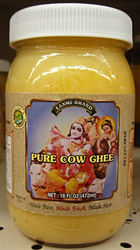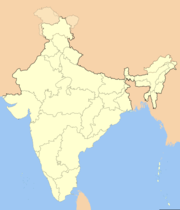Indian cuisine
 |
| This article is part of the series Indian cuisine |
| Regional cuisines |
|
Awadhi – Punjabi – Mughlai |
|
Assamese - Meghalayan – Manipuri – Mizo |
|
Andhra – Karnataka – Kerala – Tamil |
|
Bengali – Oriya |
|
Goan – Gujarati – Kutchi – Marathi – |
|
Indian Chinese – Nepali |
| Ingredients and types of food |
|
Main dishes – Desserts – Bread |
| Preparation and cooking |
|
Handi – Karahi – Tava – Uruli – Other |
| See also: |
|
History – Etiquette |
| edit |
Indian cuisine is characterized by the use of various spices, herbs and other vegetables, and sometimes fruits grown in India and also for the widespread practice of vegetarianism in Indian society. Each family of Indian cuisine includes a wide assortment of dishes and cooking techniques. As a consequence, it varies from region to region, reflecting the varied demographics of the ethnically-diverse Indian subcontinent.
Hindu beliefs and culture have played an influential role in the evolution of Indian cuisine.[1] However, cuisine across India also evolved as a result of the subcontinent's large-scale cultural interactions with Mongols and Britain making it a unique blend of various cuisines.[2][3] The spice trade between India and Europe is often cited as the main catalyst for Europe's Age of Discovery.[4] The colonial period introduced European cooking styles to India, adding to the flexibility and diversity of Indian cuisine.[5][6] Indian cuisine has influenced cuisines across the world, especially those from Southeast Asia and the Caribbean.[7][8]
Contents |
History
Indian Cooking derives from a 5000 year old timeline, during which culture has changed, geographical boundaries have changed significantly leading to confusing terms such as sub-continental cuisine while other parts of a region want a separate culinary identity. Indian Cooking has however evolved significantly over time and the varying influences brought into the country by the various rulers and travelers, it has not lost its original identity, rather become richer with the assimilation of the myriad influences. This is very apparent in some of the unique regional cuisines.
Antiquity
The earliest formal civilization was the Mohenjo-daro and Harappan civilization, at about 3000 BC, sesame, eggplant, and humped cattle had been domesticated in the Indus Valley.[9] also spices like turmeric, cardamom, black pepper and mustard were harvested in India during this period.[10] Many recipes first emerged during the initial Vedic period, when India was still heavily forested and agriculture was complemented with game hunting and forest produce. In Vedic times, a normal diet consisted of fruit, vegetables, meat, grain, dairy products and honey. Over time, some segments of the population embraced vegetarianism. This was facilitated by advent of Buddhism and a cooperative climate where variety of fruits, vegetables, and grains could easily be grown throughout the year. A food classification system that categorized any item as saatvic, raajsic or taamsic developed in Ayurveda. In this period vegetarianism also flourished throughout India, beef eating was prohibited which has become a long-standing feature in Hinduism and India.
Middle Ages
This period was the period of several North Indian dynasties, including the Gupta dynasty which was noted for its love of the arts and there were several visiting travelers during this time. This was also known as the Golden Age of India Art, there were several travelers who visited India and carried with them knowledge and products like tea and spices. Later India saw the period of Muslim Invasions who were non vegetarians unlike Hindus, Buddhists and Jains of India. This period also saw the emergence of the Mughlai cuisine that people now associate with India. It includes the addition of several seasonings like saffron, the addition of nuts and cooking in the “Dum” or sealed pot method of cooking. 18th century saw the establishment of British rule in India. This generally was hardly a glorified period in Indian history, but the British loved the general elaborate way of eating and adapted several of the food choices to their taste and developed the “curry” as a simple spice to help them cook Indian spice. This period resulted in the emergence of the Anglo-Indian cuisine and the emergence of certain “Raj” traditions like that of “high-tea” an elaborate late afternoon meal served with tea.
Ingredients

The staples of Indian cuisine are rice, atta (whole wheat flour), and a variety of pulses, the most important of which are masoor (most often red lentil), channa (bengal gram), toor (pigeon pea or yellow gram), urad (black gram), and mung (green gram). Pulses may be used whole, dehusked – for example, dhuli moong or dhuli urad – or split. Split pulses, or dal, are used extensively. Some pulses, like channa and mung, are also processed into flour (besan).
Most Indian curries are cooked in vegetable oil. In northern and western India, peanut oil is most popular for cooking, while in eastern India, mustard oil is more commonly used. Coconut oil is used widely along the western coast and in southern India; gingelly oil is common in the south as well. In recent decades, sunflower oil and soybean oil have gained popularity all over India. Hydrogenated vegetable oil, known as Vanaspati ghee, is another popular cooking medium. Butter-based ghee, or desi ghee, is less used than formerly.
The most important or frequently used spices in Indian cuisine are chilli pepper, black mustard seed (rai), cumin (jeera), turmeric (haldi, manjal), fenugreek (methi), asafoetida (hing, perungayam), ginger (adrak, inji), coriander (dhania), and garlic (lehsun, poondu). Popular spice mixes are garam masala, a powder that typically includes five or more dried spices, especially cardamom, cinnamon, and clove. Each region, and sometimes each individual chef, has a distinctive blend of garam masala. Goda masala is a similar sweet spice mix, popular in Maharashtra. Some leaves are commonly used, including tejpat (cinnamon leaf), coriander leaf, fenugreek leaf, and mint leaf. The common use of curry leaves and curry roots is typical of all South Indian cuisine. Sweet dishes are seasoned with cardamom, saffron, nutmeg, and rose petal essences.
Regional cuisines
India is a diverse country with many regional cultures, each region has its own food specialties, primarily at regional level, but also at provincial level. The differences can come from a local culture and geographical location whether a region is close to the sea or the mountains, and economics. Indian cuisine is also seasonal with priority placed on the use of fresh produce.
Jammu & Kashmir

Kashmiri cuisine has evolved over hundreds of years. The first major influence was the food of the Kashmiri Hindus and Buddhists. The cuisine was then influenced by the cultures which arrived with the invasion of Kashmir by Timur from the region of modern Uzbekistan. Subsequently, it has been strongly influenced by the cuisines of Central Asian, Persia, and the North Indian plains.The most notable ingredient in Kashmir cuisine is mutton, of which there are over 30 varieties. Also to be noted are Balti curries, popular in the United Kingdom for their exotic tastes, that were originally brought by Kashmiri immigrants hailing from the Baltistan region of Pakistan-administered Kashmir.
Kashmiri Pandit food is also very elaborate, and is an important part of the Pandits' ethnic identity. The food usually uses a lot of yogurt, oils and spices as such turmeric, but avoids onion, garlic, tomatoes, and chicken. Unlike Kashmiri Muslim cuisine, it does not include many minced meat dishes.An equal emphasis is laid on vegetarian and non-vegetarian dishes, although a bias for non-vegetarian dishes certainly exists
Punjab
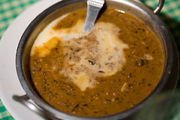

Punjabi cuisine can be non-vegetarian or completely vegetarian. One of the main features of Punjabi cuisine is its diverse range of dishes. Home cooked and restaurant Punjabi cuisine can vary significantly, with restaurant style using large amounts of clarified butter, known locally as ghee, with liberal amounts of butter and cream with home cooked concentrating on mainly upon preparations with Whole Wheat, Rice and other ingredients flavored with masalas (spices). Roh Di Kheer, is cooked using rice. Rice is cooked for a long time in sugar cane juice.Within the area itself, there are different preferences. People in the area of Amritsar prefer stuffed parathas and milk products. In fact, the area is well known for quality of its milk products.There are certain dishes which are exclusive to Punjab, such as Mah Di Dal and Saron Da Saag (Sarson Ka Saag).The food is tailor-made for the Punjabi lifestyle in which most of the rural folk burn up a lot of calories while working in the fields. The main masala in a Punjabi dish consists of onion, garlic and ginger. Tandoori food is a Punjabi speciality especially for non-veg dishes. Many of the most popular elements of Anglo-Indian cuisine - such as Tandoor, Naan, Pakoras and vegetable dishes with paneer - derive from the Punjab.
Uttar Pradesh

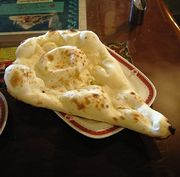
The cuisine consists of both vegetarian and non-vegetarian dishes but a vast majority of the state enjoys sober vegetarian meals with Dal, roti, sabzi and rice constituting the essentials of daily food habits. Pooris and kachoris are relished on special occasions.Uttar Pradesh has also been greatly influenced by Mughal cooking techniques. The Awadhi cuisine of Uttar Pradesh bears similarities to those of Punjab, and the state is famous for its Nawabi foods(of Lucknow and environs) and use of mutton, paneer, and rich spices including cardamom and saffron. Its most famous dishes include kebabs, Dum Biryani, and various Mutton recipes. The samosa and pakora, among the most popular snacks in all of India, are also originally from Uttar Pradesh. Awadhi is a type of West-Central Uttar Pradeshi cuisine found in the state's Awadh Region. Mughlai cuisine is also integral to Western and Central Uttar Pradesh's cuisine.
Rajasthan
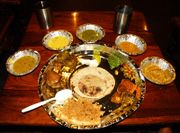
Rajasthani cooking was influenced by the war-like lifestyle of the Rajput inhabitants and the availability of ingredients in this arid region. In Rajasthan water is at a premium, and hence the food is generally cooked in milk or ghee, making it quite rich. On the other hand, Besan or gram flour is a mainstay of Marwari food mainly because of paucity of vegetables in this arid land.
There is a distinctness in the Rajasthani cuisine which comes from a tradition that is old and tranquil, and from a culture that has churned the best from its neighboring states of Gujrat, Haryana and Punjab. Food that could last for several days and could be eaten without heating was preferred. Scarcity of water and fresh green vegetables have all had their effect on the cooking. Major dishes of a Rajasthani platter includes Daal-Baati, Tarfini, Raabdi, Bail-Gatte, Panchkoota, Chaavadi, Laapsi, Kadhi and Boondi
Bihar
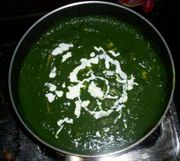
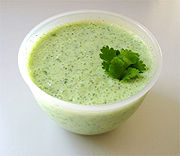
Bihari cuisine is predominantly vegetarian because traditional Bihar society influenced by Hindu and Buddhist values of non-violence did not eat eggs, chicken, fish and other animal products. However there is also a tradition of meat-eating and fish dishes are especially common due to the number of rivers in Bihar such as the Sone, Gandak and the Ganges. There are also numerous Bihari meat dishes with chicken and mutton being the most common.Dairy products are consumed frequently throughout the year, with common foods including yoghurt known as dahi and also buttermilk known as mattha, ghee, lassi and butter. The cuisine of Bihar is similar to a great extent to North Indian cuisine but has an influence from other East Indian Cuisine (for example like Bengali cuisine, Mustard oil is used in cooking). It is highly seasonal, with watery foods such as watermelon and Sherbet made of pulp of the wood-apple fruit being consumed mainly in the summer months and dry foods, preparations made of sesame seeds,poppy seeds in the winter months. Some dishes which Bihar is famous for, include Sattu Paratha, which are parathas stuffed with fried chickpea flour, Chokha (spicy mashed potatoes), Fish curry and Bihari Kebab,Postaa-dana kaa halwaa
West Bengal

Bengali cuisine is a style of food preparation originating in the eastern India which includes states of Tripura, Barak Valley of Assam and West Bengal. With an emphasis on fish and lentils served with rice as a staple diet, Bengali cuisine is known for its subtle flavours, its confectioneries and desserts, and has perhaps the only multi-course tradition from India that is analogous with French and Italian cuisine in structure. The nature and variety of dishes found in Bengali cooking are unique even in India. Fish cookery is one of its better-known features and distinguishes it from the cooking of the landlocked regions. Bengal's many rivers, ponds and lakes teem with many kinds of freshwater fish that closely resemble catfish, bass, shad or mullet. Bengalis prepare fish in innumerable ways - steamed or braised, or stewed with greens or other vegetables and with sauces that are mustard-based or thickened with poppyseeds.
Orissa
Oriya cuisine is rich and varied, while relying heavily on local ingredients. The flavors are usually subtle and delicately spiced, quite unlike the fiery curries typically associated with Indian cuisine. Fish and other seafood such as crab and shrimp are very popular. Chicken and mutton are also consumed. Panch phutana, a mix of cumin, mustard, fennel, fenugreek and kalonji (nigella) is widely used for tempering vegetables and dals, while garam masala (curry powder) and haladi (turmeric) are commonly used for non-vegetarian curries. Pakhala, a dish made of rice, water, and yoghurt, that is fermented overnight, is very popular in summer, particularly in the rural areas. Oriyas are very fond of sweets and no Oriya repast is considered complete without some dessert at the end.Vegeterian foods also include foods prepared without onion and garlic as in temple prasadam and bramhin cuisine.
Andhra Pradesh
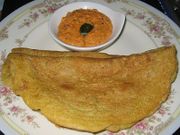
Cuisine of the southern state of Andhra Pradesh is the amalgamation of the delectable Southern Indian and refined Deccani style of cooking. A large part of the population is vegetarian and has innovated some excellent recipes while people living in the coastal areas can treat one with the best of sea food. There is also an great variety of non-vegetarian dishes and most amongst these are hugely popular. Food of Andhra Pradesh is known for its heavy use of spices and chillies. Curd is also a part of the meal in the Andhra Pradesh as it helps to neutralise the spicy nature of the food.The staple food of Andhra Pradesh is Rice, which is served with sambar. It is also served with other lentil preparations along with vegetables.
Karnataka
The cuisine of Karnataka includes many vegetarian and non-vegetarian cuisines. The varieties reflect influences from the food habits of many regions and communities from the three neighbouring South Indian states, as well as the state of Maharashtra to its north. Some typical dishes include Bisi bele bath, Jolada rotti, Chapati, Ragi rotti, Akki rotti, Saaru, Huli, Vangi Bath, Khara Bath, Kesari Bath, Davanagere Benne Dosa, Ragi mudde, and Uppittu. The famous Masala Dosa traces its origin to Udupi cuisine. Plain and Rave Idli, MysoreMasala Dosa and Maddur Vade are popular in South Karnataka. Coorg district is famous for spicy varieties of pork curries while coastal Karnataka boasts of many tasty seafood specialities. Among sweets, Mysore Pak, Dharwad pedha, Chiroti are well known.Although the ingredients differ from one region to another, a typical Kannadiga Oota (Kannadiga meal) includes the following dishes in the order specified and is served on a banana leaf: Uppu(salt), Kosambari, Pickle, Palya, Gojju, Raita, Dessert (Yes, it is a tradition to start your meal with a dessert - Paaysa), Thovve, Chitranna, Rice and Ghee
Kerala


Kerala cuisine is a blend of indigenous dishes and foreign dishes adapted to Kerala tastes. Coconuts grow in abundance in Kerala, and consequently, grated coconut and coconut milk are widely used in dishes and curries as a thickener and flavouring ingredient. Kerala's long coastline, numerous rivers and backwater networks, and strong fishing industry have contributed to many sea- and river-food based dishes. Rice is grown in abundance, and could be said, along with tapioca (manioc/cassava), to be the main starch ingredient used in Kerala food.Having been a major production area of spices for thousands of years, black pepper, cardamom, cloves, ginger, and cinnamon play a large part in its food. Since many of Kerala's Hindus are vegetarian by religion, and because Kerala has large minorities of Muslims and Christians that are predominantly non-vegetarians, Kerala cuisine has a multitude of both vegetarian and dishes prepared using fish, poultry and meat.
Tamil Nadu
Tamil food is characterized by the use of rice, legumes and lentils, its distinct aroma and flavour achieved by the blending of spices including curry leaves, tamarind, coriander, ginger, garlic, chili, pepper, cinnamon, cloves, cardamom, cumin, nutmeg, coconut and rosewater. The word "curry" is derived from the Tamil word 'kari' which means "an additive to the main course or a side dish" Rice and legumes play an important role in Tamil cuisine. Lentils are also consumed extensively, either accompanying rice preparations, or in the form of independent dishes. Vegetables and dairy products are essential accompaniments. The commonly referred staple South Indian dishes and meals like, Idly, Dosai, appam, uthappam, Idiyappam, Sambar, Rasam, Vatha Kuzhambu, Payasam, appalam etc which are considered generally as south indian food are essentially Tamil food and they are all originated from Tamil cuisine. A typical tamilian would eat Idly/Dosai/uthappam etc for breakfast and rice accompanied by lentil preparations Sambar, Rasam and curd. Tamil Nadu is famous for its spicy non vegetarian dishes (just like Andhra Pradesh). The southern regions in Tamil Nadu, namely; Kaaraikudi and Chettinaadu are famous for their spicy non vegetarian dishes.
Maharashtra
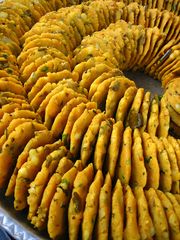
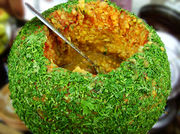
Maharashtrian cuisine covers a range from being mild to very spicy dishes. Wheat, rice, jowar, vegetables, lentils and fruit form important components of Maharashtrian diet. Popular dishes include puran poli, ukdiche Modak and batata wada. The staple dishes of Maharashtrian cuisine are based on bread and rice. The cuisine of Maharashtra has its own distinctive flavors and tastes. It can be divided into two major sections–the coastal and the interior. A major portion of Maharashtra, which lies on the coast of the Arabian Sea, is loosely called the Konkan and boasts of its own Konkani cuisine, which is a homogeneous combination of Malvani, Gaud Saraswat Brahmin, and Goan cuisines. Besides the coastal cuisine, the interior of Maharashtra—the Vidarbha area, has its own distinctive cuisine known as the Varadi cuisine. As in most of the other states of India, rice is the staple food grain in Maharashtra too. Like the other coastal states, there is an enormous variety of vegetables in the regular diet and lots of fish and coconuts are used.Grated coconuts spice many kinds of dishes, but coconut oil is not very widely used as a cooking medium. Peanuts and cashew nuts are widely used in vegetables and peanut oil is the main cooking medium. Another feature is the use of kokum, a deep purple berry that has a pleasing sweet and sour taste. Kokum, most commonly used in an appetizer-digestive called the sol kadhi, is served chilled.
Goa

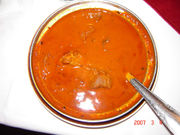
Goan cuisine consists of regional foods popular in Goa, located along India's west coast along the Arabian Sea. Seafood, coconut milk, rice and paste are main ingredients of Goan delicacies. The area is located in a tropical climate, and spices and flavors are intense. Use of Kokum is another distinct feature. Goan food cannot be considered complete without fish,The cuisine is mostly seafood based, the staple food is rice and fish. Kingfish (Vison or Visvan) is the most common delicacy, others include pomfret, shark, tuna and mackerel. Among the shellfish are crabs, prawns, tiger prawns, lobster, squid and mussels. The cuisine of Goa is influenced by its Hindu origins, four hundred years of Portuguese colonialism, and modern techniques. The state is frequented by tourists visiting its beaches and historic sites, so its food has an international aspect. Goan Saraswat Brahmin and Daivajna Brahmins are mostly fish eaters. Broadly they can be considered as facultative vegeterians, i.e. they eat fish and chicken on most of the days, while eating strict vegetarian (no meat, no-fish diet) food on some days, due to religious reasons. Fish and meat in their diet is considered as non-vegetarian.On the other hand other Brahmins belonging to Pancha Dravida category are strictly vegetarian. Their vegetarian cuisine is unique.
Gujarat
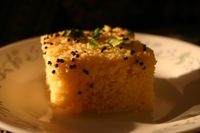
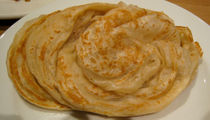
Gujarati cuisine is primarily vegetarian. The typical Gujarati Thali consists of Roti (a flat bread made from wheat flour, and called rotli in Gujarati), daal or kadhi, rice, and sabzi/shaak (a dish made up of different combinations of vegetables and spices, which may be stir fried, spicy or sweet). Cuisine can vary widely in flavor and heat, depending on a given family's tastes as well as the region of Gujarat they are from. North Gujarat, Kathiawad, Kachchh, and South Gujarat are the four major regions of Gujarat that all bring their own style to Gujarati food. Many Gujarati dishes are distinctively sweet, salty, and spicy at the same time. The cuisine changes with the seasonal availability of vegetables. In mango season, for example, Keri no ras (fresh mango pulp) is often an integral part of the meal. The spices used also change depending on the season. Garam Masala and its constituent spices are used less in summer. Regular fasting, with diets limited to milk and dried fruits, and nuts, are commonplace. Kachori , Jilebi , undhiyu ,Kakra are some of the snacks famous in Gujarat.
Assam

Assamese cuisine' is the cuisine of Assam, a state in North-East India. It is a mixture of different indigenous styles with considerable regional variations and some external influences. It is characterized by very little use of spices but strong flavors due mainly to the use of endemic exotic herbs, fruits and vegetables that are either fresh, dried or fermented. Fish is widely used, and birds like duck, pigeon etc. are very popular. Preparations are rarely elaborate—the practice of Bhuna, the gentle frying of spices before the addition of the main ingredients so common in Indian cooking, is absent in the cuisine of Assam. A traditional meal in Assam begins with a khar, a class of dishes named after the main ingredient, and ends with a tenga, a sour dish. These two dishes characterize a traditional meal in Assam. The food is usually served in bell metal utensils made by an indigenous community called Mariya. Tamul (betel nut, generally raw) and paan generally concludes the meal.
Nagaland
Naga cuisine, of the Naga people, is known for exotic meats but simple and flavorful ingredients. The meat and fish used are often smoked, dried or fermented.
Sikkim
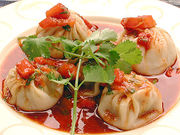
Sikkim has its own unique dietary culture with specific cuisine and food recipes. In the Sikkim Himalayas traditional foods are an integral part of the dietary culture of the various ethnic groups of people consisting of the Nepalese, Bhutias and Lepchas. Rice is the staple food. Meat and dairy products are also consumed depending on availability. Besides these, various traditional fermented foods and beverages, which constitute of about 20 per cent of the basic diet for long centuries are prepared and consumed. The dietary-culture of this region is mostly reflected in the pattern of food production. Depending on the altitudinal variation, finger millet, wheat, buckwheat, barley, vegetable, potato, soybeans, etc. are grown. Some of the common traditional cuisine with their food recipes has been presented for introduction of dietary culture of the Sikkim Himalayas, as well as for product diversification.
Tripura

The Tripuri (Tipra or Tipperah) people are the original inhabitants of the state of Tripura in North East India. The indigenous Tripuri people comprises the communities of Tipra, Reang, Jamatia, Noatia, Uchoi and others. The Tripuri people have their own culture and cuisine. The Tripuris are non-vegetarian, though there is a minority modern vaishnavite Hindu vegetarian following. The major ingredient of Tripuris cuisine for Non-vegetarian food includes pork, chicken, mutton, turtle, fish, prawns, crabs, frogs.
Arunachal Pradesh
The staple food of Arunachal Pradesh is rice along with fish, meat and lots of green vegetables. Different varieties of rice are available. Lettuce is the most common and preferred vegetable of all, prepared by boiling it with ginger, coriander and green chillies. Boiled rice cakes wrapped in leaves is a famous snack. Thukpa is traditional dish common among "monpa" a tribe of Arunachal.
Desserts
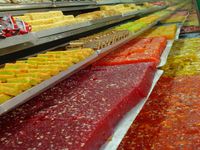

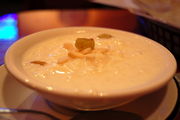
Indian sweets, known as mithai, are a type of confectionery. Many are made with sugar, milk and condensed milk, and cooked by frying. The bases of the sweets and other ingredients vary by region. In the Eastern part of India, for example, milk is a staple, and most sweets from this region are based on milk products.

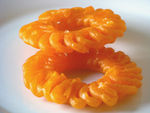
Barfi is a sweet made of dried milk with ground cashews or pistachios. It is customary to attach a thin layer of edible silver foil as decoration.
Chikki A simple sweet made out of peanuts and molasses.
Gulab jamun is an Indian dessert made out of fried milk balls soaked in sweet syrup.
Jalebi is made by deep-frying flour in a circular (coil-like) texture and then dipping in sugar syrup. Imarti is a variant of Jalebi, with a different flour mixture and has a more coild texture. Typically Jalebi is brown or yellow, while Imarti is reddish in color. Often taken with milk, tea or even yogurt (or Lassi)
Khaja is a sweet food of Orissa and Bihar states in India. Refined wheat flour, sugar and oils are the chief ingredients of khaja.
It is believed that, even 2000 years ago, Khajas were prepared in the southern side of the Gangetic Plains of Bihar. These areas which are home to khaja, once comprised the central part of Maurya and Gupta empires. Presently, Khajas are prepared and sold in the city of Patna, Gaya and several other places across the state of Bihar. Khajas of the Silao and Rajgir are known for their puffiness.
Khajas have travelled to some other parts of India, including Andhra Pradesh. Khaja of Kakinada is a coastal town of Andhra Pradesh. At first, a paste is made out of wheat flour, mawa and oil. It is then deep fried until crisp. Then a sugar syrup is made which is known as "pak". The crisp croissants are then soaked in the sugar syrup until they absorb the sugar syrup. In Kakinada Khaja, it is made dry from outside and full of sugar syrup from inside and is juicy.
Kulfis are Indian ice-cream, where the sweetened milk/cream is frozen in small metal cans to be served frozen. Usually it has a milky appearance, but additional colors may be applied for display. A summer-time favorite in most of India, especially in the northern India. It comes in variety of flavors such as mango kesar or cardamom. It is typically sold by street-side hawkers who carry around these frozen cans of kulfi in a big earthen pot. The street-side hawkers, called "kulfiwalla" (one who sells kulfi) are much awaited by school kids who savor kulfi's during school lunch-times.
Kheer is a pudding, usually made from rice and milk. It is also known as "Payas".
Laddu (sometimes transliterated as laddoo) is made of flour and other ingredients formed into balls that are dipped in sugar syrup. The popularity of Laddu is due to its ease of preparation.
Variations in the preparation of Laddu result in a spectrum of tastes. Laddu is often made to celebrate festivals or household events such as weddings.You can get Laddoo's which are famous in Bihar called as "Maner Ka Laddoo" in Maner Sweets - Maner and Patna.
Malpoa is one of the most ancient home made sweets of India. It is a form of pancake (made of what or rice flour) deep fried and sugar syrup. Several variations exist in different parts of India, especially popular in Bengal and Orissa.
Motichoor Ka Ladoo is a sweet food of the central Bihar made from grilled gram flour flakes which are sweetened, mixed with almonds, pressed into balls and fried in ghee. Originally from Maner, a small town near Patna, it is now made and consumed throughout India and Pakistan. One of the popular sweet makers for Motichoor Ka Ladoo is Maner Sweets in Maner and in Patna(Maurya Lok).It is a traditional gift at weddings, engagements and births.
A sweet rice pudding, payas has been a cultural dish throughout the history of India, being usually found at ceremonies, feasts and celebrations. In many parts of India, ancient traditions maintain that a wedding is not fully blessed if payas (or payasam as known in South India) is not served at the feast during traditional ceremonies like marriage, child birth, annaprasan (first solid feed to child) etc.
Rasgulla is a popular relished sweetmeats in India, originated in Orissa, in the eastern region of the country, but was made known to the outside world by Nobin Chandra Das of Kolkata. Originally a dessert in Orissa for centuries, this dish made its way to West Bengal when the Oriya cooks started migrating to West Bengal in search of jobs, bringing along the recipe. It was only then that Nobin Chandra Das of Kolkata modified its recipe to give it its current form. This dish is produced by the boiling of small balls of casein in sugar syrup. This sweet dessert can be found in many eastern Indian households.
Sandesh is a sweet made from fine cheese made from cow's milk kneaded with fine ground sugar or molases. This is a signature sweet from West Bengal in India. Revered for its delicate making, and appreciated by the connoiseur, this represents sweet making at its finest. Sandesh comes in two varieties, "Norom Pak" (the softer version) and "Koda Pak" (the harder version). The softer version although more gentle and considered better, is fragile. The harder version is robust and often easier for storage. Molases made from dates can be used to make a special variation of Sandesh called "Noleen Gurher Sandesh" (a Sandesh made from "Noleen Gurh" or molases from dates) or simply "Noleen Sandesh" (as shown in the figure).
Shrikhand is a creamy dessert made out of strained yogurt, from which all water is drained off, leaving the thick yogurt cream by itself. Adding dry fruits like mangoes enhances the Shrikhand’s taste. It is a Western India traditional dish, and it has ancient roots in the Indian cuisine.
Beverages
Non Alcoholic beverages
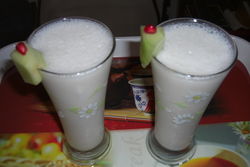
Tea is a staple beverage throughout India; the finest varieties are grown in Darjeeling and Assam. It is generally prepared as masala chai, wherein the tea leaves are boiled in a mix of water, spices such as cardamom, cloves, cinnamon, and ginger, and large quantities of milk to create a thick, sweet, milky concoction. Different varieties and flavors of tea are prepared to suit different tastes all over the country. Another popular beverage, coffee, is largely served in South India. One of the finest varieties of Coffea arabica is grown around Mysore, Karnataka, and is marketed under the trade name "Mysore Nuggets". Indian filter coffee, or kafee, is also especially popular in South India. Lassi is a popular and traditional Punjabi yogurt-based drink of India. It is made by blending yogurt with water or milk and Indian spices. Salted lassi is more common in villages of Punjab & Indian Porbandar, Gujarat. It is prepared by blending yogurt with water and adding salt and other spices to taste. The resulting beverage is known as salted lassi traditional lassi is sometimes flavored with ground roasted cumin. Sweet lassi is a form of lassi flavored with sugar, rosewater and/or lemon, strawberry or other fruit juices. Saffron lassis, which are particularly rich, it is also very popular. Sharbat is a cold sweet beverage that is prepared from fruits or flower petals.It can be served in concentrate form and eaten with a spoon or diluted with water to create the drink. Popular sharbats are made of one or more of the following: Rose, Sandalwood, Bel, Gurhal (Hibiscus), Lemon, Orange, Pineapple, Falsa (Grewia asiatica). These are known to have several medicinal values and are known to be ayurvedic in nature. Other beverages include nimbu pani (lemonade), chaach, badam doodh (almond milk with nuts and cardamom) and coconut water. In southern India, there is a chilled beverage known as "Panner Soda" or "Gholi Soda", a mixture of carbonated water, rose water, and sugar. Another beverage from the south, rose milk, is also served cold.
Alcoholic beverages
Beer
Beers in India are either lagers (4.3% alcohol — such as Australian lager) or strong lagers (7.8% alcohol - such as Australian Max Strong Beer). The Indian beer industry has been witnessing steady growth of 10 - 17% per year over the last ten years. The rate of growth has increased in recent years, with volumes passing 170m cases during the 2008-2009 financial year. With the average age of the population on the decrease and income levels on the increase, the popularity of beer in the country continues to rise. Indian beer industry has witnessed a big change during the last five years. The industry was previously dominated by competition between the United Breweries Group and the Shaw Wallace. The scenario changed, however, with the entry of SABMiller in India. The international beer giant started by acquiring small breweries in the south but then completely changed the landscape with the acquisition of Shaw Wallace’s beer portfolio. The most notable Indian brewer is United Breweries, even though there are several other popular ones including the foreign brewers.
Miscellanea
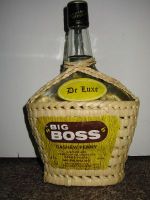
There are also several other popular alcoholic drinks in India. Fenny is a Goan liquor made from either coconut or the juice of the cashew apple and fenny (also feni) originated here. The popular brands of fenny are 'Cashyo' (the makers of which spell it feni), 'Reals' (pronounced as Reaals), and 'Big Boss'. Goa has registered for a geographical indicator that would allow it to claim the sole right to term drink created in the region as fenny or 'Goan Cashew Feni'.Hadia is a rice beer commonly made in the Bihar, Jharkhand, Orissa, Madhya Pradesh and Chhattisgarh states of India. It may alternatively be spelt hadiya. The making involves the use of herbs mixed with boiled rice and left to ferment. The drink is generally ready within a week. It is served cool and has lower alcoholic strength than other Indian country liquors. Palm wine locally known as neera is a sap extracted from Inflorescence of various species of Toddy palms. It is sweet, oyster white, and translucent. Chuak is the traditional Tripuri rice-beer. It is made by fermenting rice in water. It is usually drunk on social occasions of any Tripuri ceremony as a ritual. Chuak is offered to village elders on any occasion or celebration in a traditional Tripuri family. Chhaang is consumed by the people of Sikkim and Darjeeling Himalayan hill region of West Bengal with great enthusiasm. It is usually drunk at room temperature in summer, but is often served piping hot in brass bowls or wooden mugs when the weather is cold. Chhaang is a relative of the more universally known beer. Barley, millet (finger-millet) or rice is used to brew the drink. Semi-fermented seeds of millet are served, stuffed in a barrel of bamboo called the Dhungro. Then boiling water is poured and sipped through a narrow bore bamboo pipe called the Pipsing.
Eating Habits
People in India consider a healthy breakfast, or nashta, important. They generally prefer to drink tea or coffee with the first meal of the day. North Indian people prefer roti, parathas, and a vegetable dish, accompanied by achar (pickles) and some curd; people of western India, dhokla and milk; South Indians, idlis and dosas, generally accompanied by various chutneys.
Lunch in India usually consists of a main dish of rice in the south and east and rotis made from whole wheat in the northern and western parts of India. It typically includes two or three kinds of vegetables. Lunch may be accompanied by items such as kulcha, nan, or parathas. Curd and two or three sweets are also included in the main course. Paan (betel leaves), which aid digestion, are often eaten after lunch in parts of India.
Indian families will gather for "evening breakfast" to talk, drink tea, and eat snacks.
Dinner is considered the main meal of the day, and the whole family gathers for the occasion. Dinner may be followed by dessert, ranging from fruit to traditional desserts like kheer, gulab jamun, gajraila, qulfi or ras malai.
Etiquette
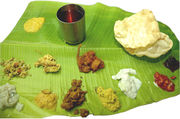
Several customs are associated with food consumption. Traditionally, meals were eaten while seated either on the floor or on very low stools or cushions. Food is most often eaten without cutlery, using instead the fingers of the right hand. Often roti (flat bread) is used to scoop the curry without allowing it to touch the hands. Other etiquette includes eating with one hand only – preferably the right hand – and letting the food touch only two phalanges of the fingers.
Traditional serving styles vary from region to region in India. One universal aspect of presentation is the thali, a large plate with samplings of different regional dishes accompanied by raita, breads such as naan, puri, or roti, and rice. Most South Indian meals end with plain curd and rice. In South India, cleaned banana leaves, which could be disposed of after the meal, were traditionally used as an alternative to plates. When hot food is served on banana leaves, the leaves add aroma and taste to the food. Leaf plates are still utilized on auspicious and festive occasions but are much less common otherwise.
Traditional ways of dining are being influenced by eating styles from other parts of the world. Among the middle class throughout India, spoons and forks are now commonly used, although knives are not.
Indian cuisine abroad
Europe
Great Britain

In 2003, there were as many as 10,000 restaurants serving Indian cuisine in England and Wales alone.[14] According to Britain's Food Standards Agency, the Indian food industry in the United Kingdom is worth £3.2 billion, accounts for two-thirds of all eating out, and serves about 2.5 million British customers every week.[15]
North America
United States and Canada
A survey held in 2007 revealed that more than 1,200 Indian food products have been introduced in the United States since 2000.[16] There are numerous Indian restaurants in across US. Indian cuisines in US are quite diverse based on region culture and climate. Major cuisines are North Indian and South Indian. There are also several places in New York, New Jersey and Chicago that have specialized cuisines that serve authentic Gujarati food.[17]
Asia
South East Asia
Indian cuisine is very popular in South East Asia because of its strong historical influence on the region's local cuisines. Indian cuisine has had considerable influence on Malaysian cooking styles[7] and also enjoys popularity in Singapore.[18][19] Indian influence on Malay cuisine dates to the 19th century.[20] Other cuisines which borrow Indian cooking styles include Vietnamese, Indonesian,[21] and Thai.[22] The spread of vegetarianism in other parts of Asia is often credited to ancient Indian Hindu and Buddhist practices.[23]
West Asia
Indian cuisine is also fairly popular in the Arab world because of its similarity to and influence on Arab cuisine.[24]
The popularity of curry across Asia has led to the dish being labeled the "pan-Asian" dish.[25] Curry's international appeal has been compared to that of pizza.[26] Though the tandoor did not originate in India, Indian tandoori dishes, such as chicken tikka, enjoy widespread popularity.[27] Historically, Indian spices and herbs were among the most sought-after trade commodities. The spice trade between India and Europe led to the rise and dominance of Arab traders, to such an extent that European explorers such as Vasco da Gama and Christopher Columbus set out to find new trade routes with India, leading to the Age of Discovery.[4]
See also
- Indian bread
- Curry
- Spices
- Multilingual list of Indian Vegetables
- Marwari Bhojnalaya
- Indian Chinese cuisine
References
- ↑ Steward, the (pb) By Dias. Books.google.com. ISBN 9788125003250. http://books.google.com/books?id=SRx9I2BqSpMC&pg=PA215&dq=indian+cuisine+diverse+most&lr=&as_brr=3&ei=kWvBSfziMpK8zATZtPHGBA&client=firefox-a#PPA215,M1. Retrieved 2009-06-23.
- ↑ Chandra, Sanjeev; Smita Chandra (February 7, 2008). "The story of desi cuisine: Timeless desi dishes". The Toronto Star. http://www.thestar.com/article/300969.
- ↑ "Indian food – Indian Cuisine – its history, origins and influences". Indianfoodsco.com. http://www.indianfoodsco.com/Classes/CulinayHistory.htm. Retrieved 2009-06-23.
- ↑ 4.0 4.1 Louise Marie M. Cornillez (Spring 1999). "The History of the Spice Trade in India". http://www.english.emory.edu/Bahri/Spice_Trade.html.
- ↑ "Foreign Influences in Modern Indian Cooking". Mit.edu. 1998-01-20. http://www.mit.edu:8001/people/alycem/writing_indiancooking.html. Retrieved 2009-06-23.
- ↑ "History of Indian Food and Cooking". Inmamaskitchen.com. http://www.inmamaskitchen.com/Indian_Cooking/history_Indian_food_cooking.html. Retrieved 2009-06-23.
- ↑ 7.0 7.1 "Bot generated title ->". Veg Voyages<!. http://www.vegvoyages.com/food.htm. Retrieved 2009-06-23.
- ↑ "Asia Food Features". Asiafood.org. http://www.asiafood.org/features_dietary_culture4.cfm. Retrieved 2009-06-23.
- ↑ Diamond 1997, p. 100
- ↑ Curry, Spice & All Things Nice: Dawn of History
- ↑ Candie Yoder. "Masala Chai". http://www.culinaryteas.com/Masala_Chai.html.
- ↑ M. Soundariya Preetha. "As coffee gets popular". http://www.hindu.com/2008/03/30/stories/2008033058640200.htm.
- ↑ "Robin Cook's chicken tikka masala speech". London: The Guardian. 2002-02-25. http://www.guardian.co.uk/world/2001/apr/19/race.britishidentity. Retrieved 2001-04-19.
- ↑ "Professor says Indian eateries are experiencing a U.S. boom". University of North Texas News Service. October 13, 2003. http://web3.unt.edu/news/story.cfm?story=8673.
- ↑ "Food Standards Agency – Curry factfile". http://www.food.gov.uk/news/newsarchive/2003/nov/curryfacts.
- ↑ Monica Bhide (January 24, 2007). "Tikka in No Time". Washington Post. http://www.washingtonpost.com/wp-dyn/content/article/2007/01/23/AR2007012300296_pf.html.
- ↑ http://www.immihelp.com/yellowpages/indian-restaurants-usa.html
- ↑ "Indian food gains popularity during Chinese New Year". February 20, 2007. http://www.hindustandainik.com/news/181_1933405,001100020009.htm.
- ↑ Viviane Then. "Go India: Curry, my love?". http://www.streetdirectory.com/restaurants/singapore/reviews/restaurant-Go_India-1000000999.php.
- ↑ "About Food in Malaysia". http://www.travellersworldwide.com/11-malaysia/11-malaysia-food.htm.
- ↑ Nancy Freeman. "Ethnic Cuisine: Indonesia". http://www.sallys-place.com/food/cuisines/indonesia.htm.
- ↑ "Thai Kitchen in East Lansing, MI". http://www.restaurantdb.net/restaurants/profile-103.html.
- ↑ Ann Kondo Corum (2000). Ethnic Foods of Hawai'i. Bess Press. p. 174. ISBN 9781573061179. http://books.google.com/books?id=RI9BPVDH8HsC&pg=PA174&lpg=PA174&dq=indian+arab+cuisine+influence+-restaurant+-recipes+-earthquake&source=web&ots=tB-g-vxs2A&sig=PdMjRcIkC1zqWYda9nNVyuAs0FI&hl=en&sa=X&oi=book_result&resnum=10&ct=result.
- ↑ K.S. Ramkumar (16 June 2006). "‘Indian Cuisine Is Popular as It’s Close to Arabic Food’". Arab News. http://www.arabnews.com/?page=4§ion=0&article=83892&d=16&m=6&y=2006&pix=world.jpg&category=World.
- ↑ "Meatless Monday: There's No Curry in India". http://www.meatlessmonday.com/site/PageServer?pagename=dyk_curry.
- ↑ Lizzie Collingham (2006-02-01). "'Curry,'". The New York Times – Book Reviews. http://www.nytimes.com/2006/02/01/books/01grim.html. Retrieved 2010-05-05.
- ↑ "Tandoori Village Restaurant Brisbane". AsiaRooms.com. http://www.asiarooms.com/travel-guide/australia/brisbane/what-where-to-eat/indian-restaurants-in-brisbane/tandoori-village-restaurant-brisbane.html.
Bibliography
- {{Citation |last1=Diamond |given1=J |year=1997 |title=Guns, Germs, and Steel: The Fates of Human Societies |publisher=W. W. Norton & Company |
External links
|
|||||||
|
||||||||||||||
|
|||||||||||||||||||||||||||||
